
The bushwren, bush wren, or mātuhituhi in Māori, was a very small and almost flightless bird that was endemic to New Zealand. It had three subspecies on each of the major islands of New Zealand, the North Island, South Island, and Stewart Island and nearby smaller islands. The species disappeared gradually after the introduction of invasive mammalian predators, last being seen on the North Island in 1955 and the South Island in 1968. Attempts were made to save the remaining population on small islands off Stewart Island, but they ultimately failed with the death of the last remaining known birds in 1972.

Iochroma is a genus of about 34 species of shrubs and small trees belonging to the nightshade family Solanaceae. They are found in the forests of South America and Mexico. They range from Colombia to Argentina or when certain species are excluded from Colombia to Peru. Their hummingbird-pollinated flowers are tubular or trumpet-shaped, and may be blue, purple, red, yellow, or white, becoming pulpy berries. The cupular (cup-shaped) calyx is inflated in some species. The leaves are alternate, simple, and entire.

The western black rhinoceros or West African black rhinoceros is an extinct subspecies of the black rhinoceros. It was declared extinct by the IUCN in 2011. The western black rhinoceros was believed to have been genetically different from other rhino subspecies. It was once widespread in the savanna of sub-Saharan Africa, but its numbers declined due to poaching. The western black rhinoceros resided primarily in Cameroon, but surveys since 2006 have failed to locate any individuals.

The long-footed potoroo is a small marsupial found in southeastern Australia, restricted to an area around the coastal border between New South Wales and Victoria. It was first recorded in 1967 when an adult male was caught in a dog trap in the forest southwest of Bonang, Victoria. It is classified as vulnerable.
The Kashmir cave bat is a species of vesper bat. It is endemic to the Western Himalayas of South Asia. It is found in the Western Himalayan broadleaf forests ecoregion, within Bhutan, India, Nepal, Pakistan, and Afghanistan.
The big-eared swamp rat is a species of rodent in the family Muridae. It is found in Angola, Cameroon, Central African Republic, Republic of the Congo, Democratic Republic of the Congo, Equatorial Guinea, Gabon, Nigeria, Uganda, and Zambia. Its natural habitat is subtropical or tropical moist lowland forests.
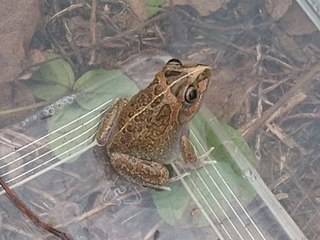
Ranoidea longipes, the long-footed frog, is a species of frog in the family Pelodryadidae endemic to Australia. Its natural habitats are subtropical or tropical dry lowland grassland and intermittent freshwater marshes.

Eleutherodactylus longipes is a species of frog in the family Eleutherodactylidae. It is endemic to Mexico and occurs on the Sierra Madre Oriental between central Nuevo León and adjacent Coahuila in the north and northern Hidalgo in the south. It is also known as the long-footed chirping frog and longfoot robber frog, among other names.
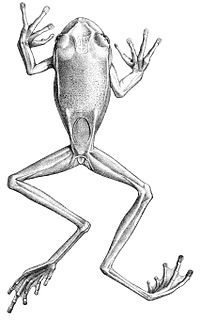
Gastrotheca longipes, also known as the Pastaza marsupial frog, is a species of frog in the family Hemiphractidae. It is found in Ecuador and Peru. Its natural habitats are subtropical or tropical moist lowland forests and subtropical or tropical moist montane forests.

Megophrys longipes is a species of frog in the family Megophryidae. It is also known as the Malacca spadefoot toad, red legged spine-eyed frog, red-legged horn frog, and slender-legged horned frog. It is found in the Malay Peninsula. Records from Cambodia and Vietnam are considered doubtful.
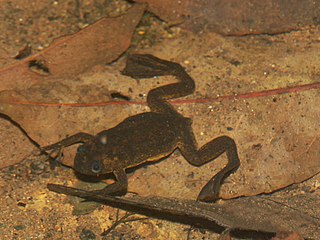
The Lake Oku clawed frog is a species of frog in the family Pipidae, endemic to Lake Oku, a small crater lake in northwest Cameroon. It is a small, dark-coloured, fully aquatic frog with a length of 28 to 36 mm, males being slightly smaller than females. The International Union for Conservation of Nature has rated this frog as "critically endangered" on the basis of its small area of occurrence at a single location, and the possibility that introduction of non-native fish into the lake could cause the frog to be wiped out.

The long-footed treeshrew is a treeshrew species within the Tupaiidae. It is endemic to Borneo and threatened due to deforestation and degradation of habitat.

The Savanna swamp shrew is a species of mammal in the family Soricidae. It is endemic to Nigeria. Its natural habitat is swamps. It is threatened by habitat loss.
Canthocamptus longipes is a species of crustacean in the family Canthocamptidae. It is endemic to Australia.
Iochroma brevistamineum is a species of plant in the family Solanaceae. It is endemic to Ecuador.
Iochroma lehmannii is a species of plant in the family Solanaceae. It is endemic to Ecuador, specifically in the Chimborazo Province in the High Andes. Its flowers are yellow-green.
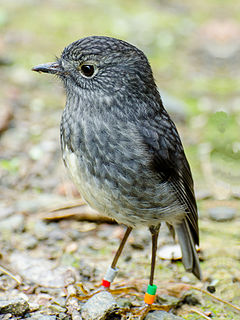
The North Island robin is a species of Australasian robin endemic to the North Island of New Zealand. It and the South Island robin of the South Island and Stewart Island were once considered conspecific, but mitochondrial DNA sequences have shown that the two lineages split prior to the Pleistocene, and support the classification as two different species.
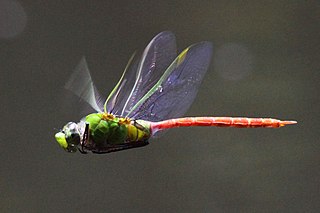
The comet darner is a common species of dragonfly of the family Aeshnidae.

Panulirus longipes, the longlegged spiny lobster, is a species of spiny lobster that lives on shallow rocky and coral reefs in the tropical Indo-Pacific region. The International Union for Conservation of Nature has assessed its conservation status as being of "least concern".

Tenuidactylus longipes, also known as Nikolsky's long-toed gecko or the long-legged thin-toed gecko, is a species of gecko that is found in Iran and southern Turkmenistan. The subspecies microlepis is sometimes considered a distinct species.















